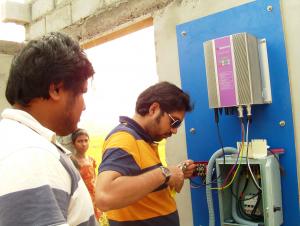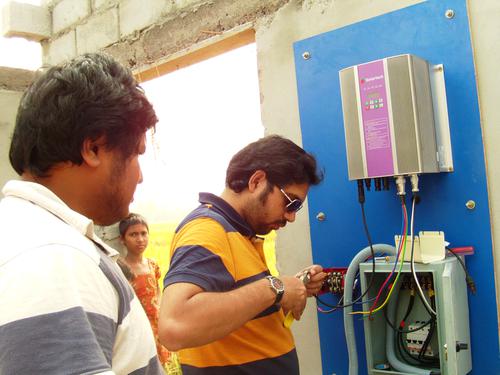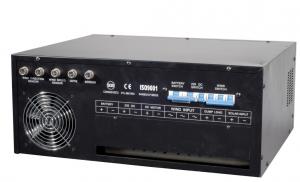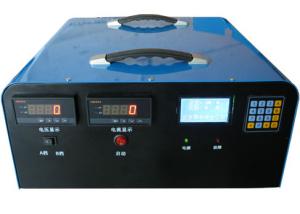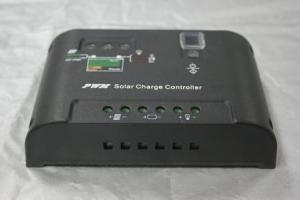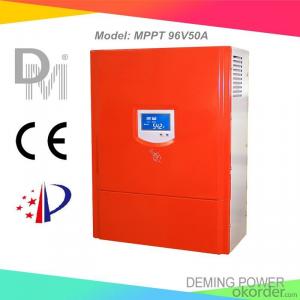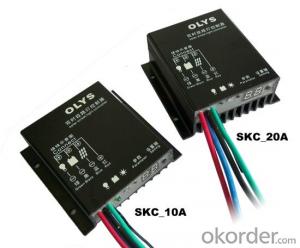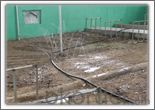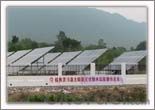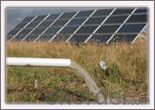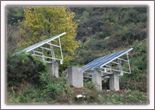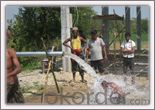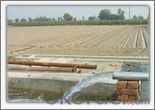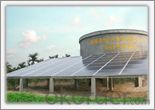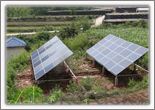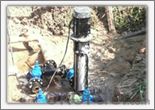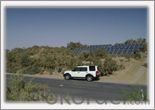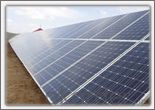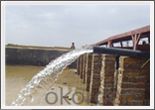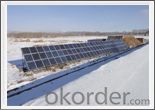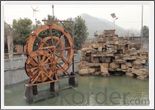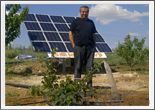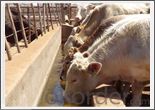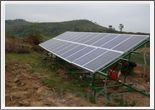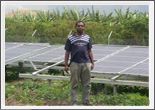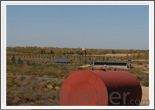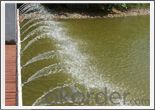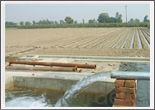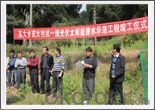40A DC Solar Water Pump Controller - Pumping System
- Loading Port:
- Shekou
- Payment Terms:
- TT OR LC
- Min Order Qty:
- 20 set
- Supply Capability:
- 100000 set/month
OKorder Service Pledge
OKorder Financial Service
You Might Also Like
Products
Solar Inverter Introduction:
Solar pumping inverter converts DC current from the solar array into AC current to drive the pump. With the function of MPPT (maximum power point tracking), it regulates the output frequency according to irradiation in real time to achieve the maximum power.
Solar Inverters Features:
1. Adopting the proposed dynamic VI maximum power point tracking (MPPT) control method; Fast response and stable operation; Better than the conventional methods which may lead to the problems including poor tracking performances, unstable or even cause water hammer damaging when the irradiation on the array changes rapidly.
2. The solar pumping inverters system is dispensed with energy storing devices, and stores water instead of electricity. It improves the reliability of the device, at the same time, it lowers the construction and maintenance costs of the system dramatically.
3. Digital control; automatic operation and data acquisition/storage of 8 years, etc; 98% of conversion efficiency, and complete protection.
4. In-line blocks; user friendly; convenient for operating; perfect cooling and shielding.
Technical Featrues
Solar Pumping Inverter Advantages:
1. To drive pumps equipped with 3-phase induction motors.
2. Optimized SPWM.
3. Various operation modes and MPPT algorithms are available.
4. Adjustable speed range of pump based on the actual situation of the system.
5. Available option of water-level detecting and control circuit.
6. Protection functions: lightning, over/low input voltage, over current and over load protection, etc.
7. Enclosure class: IP52.
8. Ambient temperature:-10~+50˚C.
Success Stories
►Middle East ►NaQu ►GuiLin
►Turkey ►XiNing ►YunNan
►Army stationed island ►Bangladesh ►Pakistan
►HaiNan ►HuBei ►Uganda
►XinJiang ►NingXia ►Afghan
►Zimbabwe ►Inner Mongolia ►Zhejiang
►Guangxi Guilin ►Turkey2 ►Botswana
►Naning ►Uganda ►Shaanxi
►Tsinghua University ►Pakistan ►Yunnan2
►FuJian ►Banqladesh ►YunNan3
►Turkey ►Inner Mongolia ►Senegal
Product Specifications
Model | Maximum input dc voltage | Recommended MPP Voltage | Rated Output Current | Output Voltage | Output Frequency | Net Weight | Gross Weight | Package Size | ||
Length | Width | Height | ||||||||
PB400L | 450 | 280-350 | 3 | 3PH 220V | 0-50 | 3.4 | 4.9 | 320 | 280 | 225 |
PB750L | 450 | 280-350 | 5 | 3PH 220V | 0-50 | 3.4 | 4.9 | 320 | 280 | 225 |
PF750L | 450 | 150-350 | 5 | 3PH 220V | 0-60 | 6.1 | 7.1 | 425 | 325 | 250 |
PB1500L | 450 | 280-350 | 7 | 3PH 220V | 0-50 | 4.0 | 5.6 | 355 | 280 | 225 |
PF1500L | 450 | 150-350 | 7 | 3PH 220V | 0-60 | 7.5 | 8.5 | 425 | 325 | 285 |
PB2200L | 450 | 280-350 | 11 | 3PH 220V | 0-50 | 4.0 | 5.6 | 355 | 280 | 225 |
PF2200L | 450 | 150-350 | 11 | 3PH 220V | 0-60 | 7.9 | 9.0 | 425 | 325 | 285 |
PB3700LA | 450 | 280-350 | 17 | 3PH 220V | 0-50 | 7.2 | 9.5 | 425 | 325 | 285 |
PB5500LA | 450 | 280-350 | 25 | 3PH 220V | 0-50 | 7.3 | 9.6 | 425 | 325 | 285 |
PB3700H | 750 | 500-600 | 9 | 3PH 380V | 0-50 | 7.2 | 9.5 | 425 | 325 | 285 |
PB5500H | 750 | 500-600 | 13 | 3PH 380V | 0-50 | 7.3 | 9.6 | 425 | 325 | 285 |
PB7500H | 750 | 500-600 | 18 | 3PH 380V | 0-50 | 7.7 | 10 | 425 | 325 | 285 |
PB11KH | 750 | 500-600 | 24 | 3PH 380V | 0-50 | 8.2 | 10.5 | 425 | 325 | 285 |
PB15KH | 750 | 500-600 | 30 | 3PH 380V | 0-50 | 8.4 | 10.7 | 425 | 325 | 285 |
PB18KH | 750 | 500-600 | 39 | 3PH 380V | 0-50 | 8.4 | 10.7 | 425 | 325 | 285 |
PB22KH | 750 | 500-600 | 45 | 3PH 380V | 0-50 | 18 | 21 | 600 | 465 | 350 |
PB30KH | 750 | 500-600 | 60 | 3PH 380V | 0-50 | 18 | 21 | 600 | 465 | 350 |
PB37KH | 750 | 500-600 | 75 | 3PH 380V | 0-50 | 20 | 23 | 600 | 465 | 350 |
PB45KH | 750 | 500-600 | 91 | 3PH 380V | 0-50 | 20 | 23 | 600 | 465 | 350 |
PB55KH | 750 | 500-600 | 112 | 3PH 380V | 0-50 | 20 | 23 | 600 | 465 | 350 |
- Q: Can a solar controller be used with solar-powered electric vehicle chargers?
- Yes, a solar controller can be used with solar-powered electric vehicle chargers. A solar controller helps regulate the flow of electricity from the solar panels to the charger, ensuring efficient charging and protecting the batteries. It also helps in managing the charging process and preventing overcharging.
- Q: How do I choose the right solar controller for my solar panel system?
- To ensure optimal performance and longevity of your solar panel system, it is crucial to choose the right solar controller. Here are some important factors to consider when selecting: 1. System Voltage: Determine the voltage of your solar panels and batteries and find a compatible solar controller. Common voltages include 12V, 24V, and 48V. 2. Maximum Current: Take into account the maximum current generated by your solar panels and select a controller capable of handling that current. Avoid exceeding the controller's maximum current rating to prevent damage. 3. Controller Type: There are three main types of solar controllers: PWM (Pulse Width Modulation), MPPT (Maximum Power Point Tracking), and basic on/off controllers. PWM controllers are suitable for smaller systems, while MPPT controllers are more efficient and recommended for larger systems. 4. Efficiency: Seek a controller with high efficiency ratings to maximize energy harvest from your solar panels, particularly in low light conditions. 5. Load Control: Determine if you need a solar controller that can directly handle loads or if a separate load controller is necessary. Some controllers have built-in load control capabilities, enabling direct power supply to low voltage appliances. 6. Temperature Compensation: If your solar panels will be exposed to varying temperatures, consider a controller with temperature compensation. This feature adjusts charging parameters based on temperature, ensuring optimal charging and battery performance. 7. Protection Features: Ensure the solar controller includes protection features like overcharge, over-discharge, short circuit, and reverse polarity protection. These features safeguard batteries and equipment from damage. 8. Display and Monitoring: Consider controllers with built-in displays for valuable information on system performance and battery status. Some controllers also offer remote monitoring capabilities, allowing you to monitor your system from a distance. 9. Brand Reputation and Warranty: Conduct research on reputable brands known for producing reliable and durable solar controllers. Check warranty information to ensure protection against defects or malfunctions. It is essential to consult with professionals or conduct thorough research before finalizing your decision. They can provide valuable insights and help you select the solar controller that best suits your specific solar panel system requirements.
- Q: How does a solar controller handle lightning strikes or power surges?
- A solar controller is designed to protect the solar panel system from lightning strikes or power surges. It typically has built-in protection mechanisms to handle these situations. During a lightning strike or power surge, the solar controller will detect the sudden increase in voltage and current and activate its protective features. One of the main components that handle these events is the surge protector or transient voltage suppressor. This device is designed to divert the excess voltage and current away from the solar controller and the rest of the system. Additionally, the solar controller may have fuses or circuit breakers that will trip or blow in the event of a power surge or lightning strike. These protective devices are designed to interrupt the flow of electricity and prevent damage to the solar controller and other connected components. Furthermore, some solar controllers have built-in grounding mechanisms to dissipate the excess energy caused by lightning strikes. This grounding system helps to divert the energy safely into the ground, protecting the solar panel system from damage. It is important to note that while solar controllers have protective measures in place, they may not be able to completely eliminate the risk of damage from a direct lightning strike. In such cases, additional surge protection devices, like lightning arrestors or lightning rods, may be required to ensure the safety of the solar panel system. Overall, a solar controller is designed to handle lightning strikes or power surges by diverting excess energy, tripping fuses or circuit breakers, and utilizing grounding mechanisms to protect the system from damage.
- Q: How do I protect a solar controller from dust and debris?
- To ensure the protection of your solar controller against dust and debris, various steps can be taken: 1. Opt for a clean and dust-free environment for installing the solar controller. Select a location that is less prone to dust accumulation, avoiding construction sites or areas with high levels of dust and debris. 2. Utilize a protective enclosure or case that is weatherproof and resistant to dust. Install the solar controller in an enclosure specifically designed for solar controllers, ensuring adequate ventilation to prevent overheating. 3. Maintain cleanliness in the vicinity of the solar controller. Keep the immediate area surrounding the controller free from dust or debris. Employ a soft brush or cloth to gently eliminate any accumulated dust that may obstruct ventilation or hinder the controller's performance. 4. Incorporate filters into the system. Consider implementing air filters or dust screens on the vents or openings of the enclosure to further prevent the entry of dust and debris into the solar controller. These filters can be periodically replaced or cleaned to maintain their effectiveness. 5. Perform regular maintenance. Routinely inspect and clean the solar controller to ensure it remains free of dust and debris. Adhere to the manufacturer's recommendations for maintenance tasks, such as cleaning the vents, checking for dust buildup on internal components, or replacing filters as needed. By implementing these measures, you can significantly reduce the chances of dust and debris impacting the performance and durability of your solar controller.
- Q: Can a solar controller be used with solar panels of different wattage?
- Yes, a solar controller can be used with solar panels of different wattage. A solar controller's main function is to regulate the charging process of the solar panels, ensuring that the batteries are charged optimally and preventing overcharging or damage. It does not depend on the wattage of the solar panels. However, it is important to consider the voltage compatibility between the solar controller and the solar panels. The solar controller should be able to handle the voltage range of the solar panels to effectively regulate the charging process.
- Q: What is the maximum current a solar controller can handle?
- The maximum current a solar controller can handle depends on its specifications and capacity. It varies from model to model, but generally, solar controllers can handle currents ranging from a few amps to several hundred amps.
- Q: How does a solar controller handle voltage drops in the system?
- A solar controller handles voltage drops in the system by regulating and maintaining a consistent voltage level. It constantly monitors the voltage and adjusts the charging parameters to compensate for any drops, ensuring that the batteries receive a steady and optimal charge.
- Q: What is the maximum power rating that a solar controller can handle?
- The maximum power rating that a solar controller can handle varies depending on its specific model and design. However, in general, solar controllers are capable of handling power ratings ranging from a few hundred watts to several kilowatts.
- Q: How do I connect solar panels to a solar controller?
- To connect solar panels to a solar controller, you will need to follow a few simple steps. First, identify the positive (+) and negative (-) terminals on both the solar panels and the solar controller. Then, use appropriate cables and connectors to connect the positive terminal of the solar panel to the positive terminal of the solar controller, and the negative terminal of the solar panel to the negative terminal of the solar controller. Ensure that the connections are secure and tight. Finally, double-check the wiring and make sure everything is properly connected before turning on the solar system.
- Q: How do you prevent battery sulfation with a solar controller?
- Battery sulfation occurs when lead sulfate crystals build up on the battery plates, reducing its capacity and lifespan. To prevent battery sulfation with a solar controller, it is crucial to ensure proper charging and maintenance. A solar controller regulates the charging process, preventing overcharging or undercharging of the battery. By maintaining a correct charging voltage and ensuring a complete charge cycle, the solar controller minimizes the risk of sulfation. Additionally, regular battery maintenance, such as checking electrolyte levels and cleaning terminals, helps prevent sulfation and ensures optimal performance of the battery.
Send your message to us
40A DC Solar Water Pump Controller - Pumping System
- Loading Port:
- Shekou
- Payment Terms:
- TT OR LC
- Min Order Qty:
- 20 set
- Supply Capability:
- 100000 set/month
OKorder Service Pledge
OKorder Financial Service
Similar products
Hot products
Hot Searches
Related keywords
